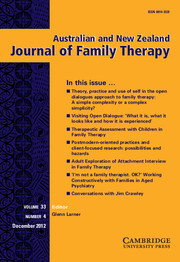Article contents
Therapeutic Responses to Communities Affected by Disasters: The Contribution of Family Therapy
Published online by Cambridge University Press: 06 November 2012
Abstract
This article is underpinned by the premise that for recovery, healing and post-traumatic growth to occur after traumatic events such as technological and natural disasters, massacres and terrorist attacks, effective therapeutic services need to be offered at both the individual and community level. Frequently, responses to such traumatic instances have been conceptualised as discrete, polarised interventions offered by various groups of health and welfare professionals at various points post the traumatic event. Traditionally when therapeutic interventions are considered, many practitioners assume that the response would, and should, focus primarily and narrowly, on individuals or their families and the symptoms of post-traumatic stress. Conversely, the perceived role of community wide interventions has been unnecessarily limited to disaster relief or organised emergency responses most usually offered at the time of the crisis. The consequence of these limited understandings is an apparent failure to explore fully the therapeutic or mediating role of social or community support in surviving trauma. Interventions encompassing the level of community might be therapeutic in two fundamental ways. First, if practitioners embraced ideas from systemic family therapy literature, ideas that acknowledge the importance of social networks, this would encourage a more holistic vision of resilience and recovery. Second, if practitioners recognised that whole communities and social networks might also be traumatised, they could provide support and interventions oriented toward healing at this broader level.
- Type
- Articles
- Information
- Australian and New Zealand Journal of Family Therapy , Volume 33 , Issue 3: Trauma and Systemic Therapy , September 2012 , pp. 242 - 256
- Copyright
- Copyright © The Authors 2012
References
- 7
- Cited by




